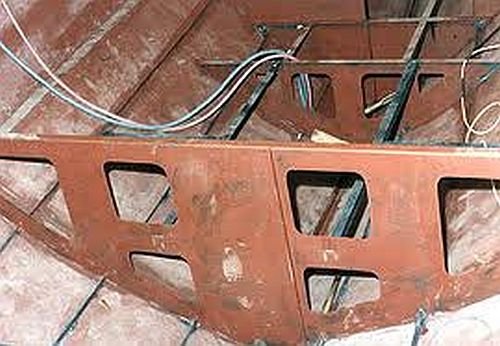.....excerpt
Why steel? It's an inexpensive material, easily fabricated, and very durable. It's a material that inspires confidence in a boat's survivability from mishaps and collisions by both experienced boat owners and newly minted ones.
I would propose that this steel hull could be built in a 'frameless fashion'.
http://5psi.net/index.php?q=node/11
View attachment 22059
View attachment 22060
As noted the computer cut steel panels are welded-up together while supported by this external jig-frame. Then the internal framing members (stringers, frames, bulkheads) can be added as deemed necessary. I've attached another photo example of a bulkhead with stringers. I think the Pilgrim design could get along fine with 5 of these major bulkhead types tying the hull sides together, and supporting the thick sandwich-cored deck I wish to place on top of their upper edges.
View attachment 22061
Note that the welded-up hull, with the bulkheads all installed, could remain in the jig-frame fixture while the engine and other equips are being installed (no deck is installed yet). The deck piece, and then major cabin superstructure, could actually be assembled on another part of the shop floor and then brought over and placed onto the assembled hull.
There are several other advantages to this steel hull idea. You will note that I mention 'computer cut panels' of steel. This not only shortens the time of construction of the steel hull, it also makes it a potential kit-boat candidate.
It has yet another potential benefit. Unlike a fiberglass hull where I am married to a single bottom design, I can change this hull's bottom design readily if something new looks feasible.








